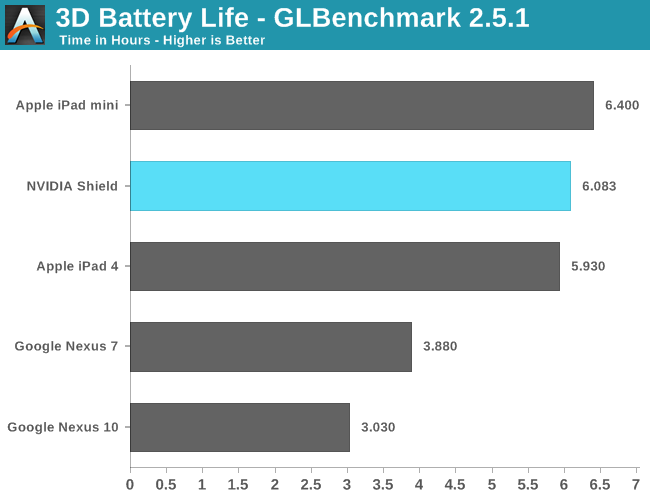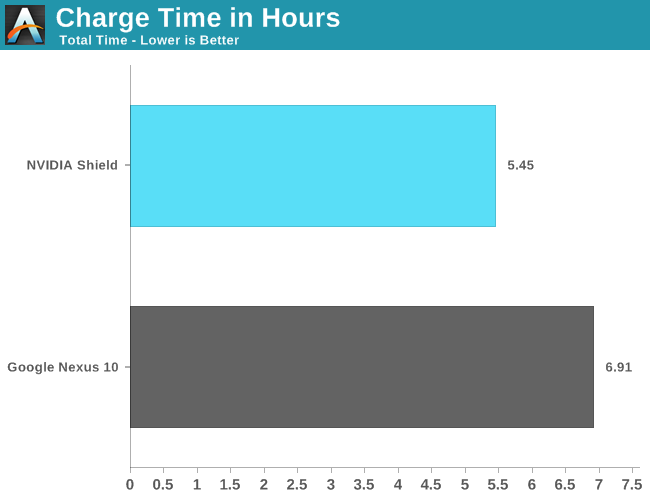NVIDIA Shield Review: At the Crossroads of PC and Mobile Gaming
by Brian Klug on July 31, 2013 12:14 AM ESTBattery Life
NVIDIA's Shield includes a 28.8Wh battery, which is large for a device its size but small compared to what you'd find in a 10-inch tablet for example. The good news is that it only has to power a 5-inch 720p display, which makes the choice of battery size quite nice. Since Shield is a fully functioning mobile device, we put it through our current battery life suite. Normally we'd start with our WiFi web browsing test, but given the target market for Shield I figured starting with our 3D rundown test made the most sense.
Here we have a loop of the Egypt HD benchmark, capped to 30 fps, running on all of the devices with their screens calibrated to 200 nits.

Shield manages just over 6 hours of use on a single charge, putting it up there with some of the best mobile devices we've put through this test. Being able to support 6 hours of locally rendered gaming without plugging in is pretty decent I'd say.
Video decode is also quite important, especially when you consider the use case where Shield acts as a remote display and controller for games rendered on your PC. In that case, the GPU is mostly powered down and only the video decode block is used to display what's being rendered on your PC. Our video playback test might be a good simulation of this use case. Our test remains unchanged from previous tablet reviews. Here I'm playing a 4Mbps H.264 High Profile 720p rip I made of the Harry Potter 8 Blu-ray. The full movie plays through and is looped until the battery dies. Once again, the displays are calibrated to 200 nits:

Tegra 4's video decode engine combined with a tiny 720p display and a 28.8Wh battery results in awesome battery life here - almost 19 hours on a single charge. If you can deal with the small screen, Shield might make for a good companion on long haul international flights just for video playback.
Finally we've got our standard web browsing battery life test:
We regularly load web pages at a fixed interval until the battery dies (all displays are calibrated to 200 nits as always). The differences between this test and our previous one boil down to the amount of network activity and CPU load.
On the network side, we've done a lot more to prevent aggressive browser caching of our web pages. Some caching is important otherwise you end up with a baseband/WiFi test, but it's clear what we had previously wasn't working. Brian made sure that despite the increased network load, the baseband/WiFi still have the opportunity to enter their idle states during the course of the benchmark.
We also increased CPU workload along two vectors: we decreased pause time between web page loads and we shifted to full desktop web pages, some of which are very js heavy. The end result is a CPU usage profile that mimics constant, heavy usage beyond just web browsing. Everything you do on your device ends up causing CPU usage peaks - opening applications, navigating around the OS and of course using apps themselves. Our 5th generation web browsing battery life test should map well to more types of mobile usage, not just idle content consumption of data from web pages.

Once again, excellent battery life from Shield.
NVIDIA ships Shield with a 10W (2.1A) power adapter, capable of completely charging Shield in 5.45 hours:











134 Comments
View All Comments
pancakes - Wednesday, July 31, 2013 - link
I heard they used Mini-HDMI because it's the most secure when moving the device around (via http://www.androidpolice.com/2013/07/30/nvidia-shi...VulgarDisplay - Wednesday, July 31, 2013 - link
I incredulously read the praise being heaped upon this device wondering what type of NDA had been agreed to for such an upbeat review of this odd and all but useless device and then I got to the end.I love the passive aggressive way of confirming what everyone already knows about the Shield, there is absolutely no reason to buy this over a smartphone. Don't worry guys, it offers minimal hitching and low latency when played on the toilet a room away from where your PC with no latency and a usable screen is sitting using up energy to stream games to a device that also uses energy. Oh, and don't forget that this brick with a fan is faster than a 10mm thick tablet that has a more usable screen that when paired with a ps3 controller would actually make a more portable gaming package.
So many of the uninformed are going to be extremely disappointed that the only way that the PC streaming will actually provide a good experience is by using it in the same house as the PC you are streaming from.
Cohaagen - Wednesday, July 31, 2013 - link
There is absolutely no reason to buy this over a smartphone?If you want a smartphone, this is the wrong device. But I'm searching for a fast device, which can handle all Android games now and the next few years and has a good battery life.
Even the actual Android-flagships Galaxy S4, HTC One and Xperia Z (both much more expensive than the Nvidia Shield) are slower than the Shield.... the PS3 controller not even counted in. Their battery life is worse.
Due to their 1080p-displays, their performance limit will be reached much sooner by more demanding games... the same goes for the new Nexus 7. I really like the decision of Nvidia, not to follow the ppi craze, 720p is perfectly fine for a gaming device with 5"-display.
Cohaagen - Wednesday, July 31, 2013 - link
Correction:Even the actual Android-flagships Galaxy S4, HTC One and Xperia Z (all of them much more expensive than the Nvidia Shield, the PS3 controller not even counted in) are slower than the Shield. Their battery life is worse.
chizow - Sunday, August 4, 2013 - link
Yes looking at some benchmarks around the Net, I didn't realize how fast this thing is. It's also significantly faster than the leaked Snapdragon S800 version of the Galaxy S4. Too bad Nvidia couldn't get Tegra 4's thermals under control, it's quite the performer.GrahamAudio - Wednesday, July 31, 2013 - link
Is there a camera?blanarahul - Wednesday, July 31, 2013 - link
The last line of the article pretty much sums up everything. I wish they would do something like Project Phoenix.ET - Wednesday, July 31, 2013 - link
Thanks for the review. The Shield looks like it right for my needs, and I'm glad it turned out to be well implemented. I might buy it at some point (if I have someone to bring it from the US), and finally get to play some of the PC games I don't get to play because my gaming time is usually away from my PC. Then again by that time I might be playing games such as Shadowrun Returns, Broken Age and Deus Ex: The Fall on my Nexus 7 and won't feel the need to buy it. And maybe, just maybe, Kainy will work well enough one day to provide decent PC streaming. Still, it's a tempting device for me.Heavensrevenge - Wednesday, July 31, 2013 - link
I REALLY hope they just say screw developing this too much to waste resources on it beyond now to beat this dead horse, I agree 100% Nvidia should mold this beast device into a super smartphone factor and rip Google Nexus' a new one.It's a cool device, but it's ~90% useless to ~90% of people (me included) .
So if they make a super kick-ass extreme battery life super-phone, I'd definitely buy one of those!
But Shield will never be in my wish-list of things to get ok Nvidia? If your reading this... Give us the best phones in a year or so and be done with this down-scaling prototype and get past this foreplay to the action of a beast phone which this thing dreams to grow up into.
JNo - Wednesday, July 31, 2013 - link
Sot it's of potential use to 10% of the population? That's still a huge market!What's with all the hate. Not every device has to have universal appeal. Those who see the value in it know who they are.